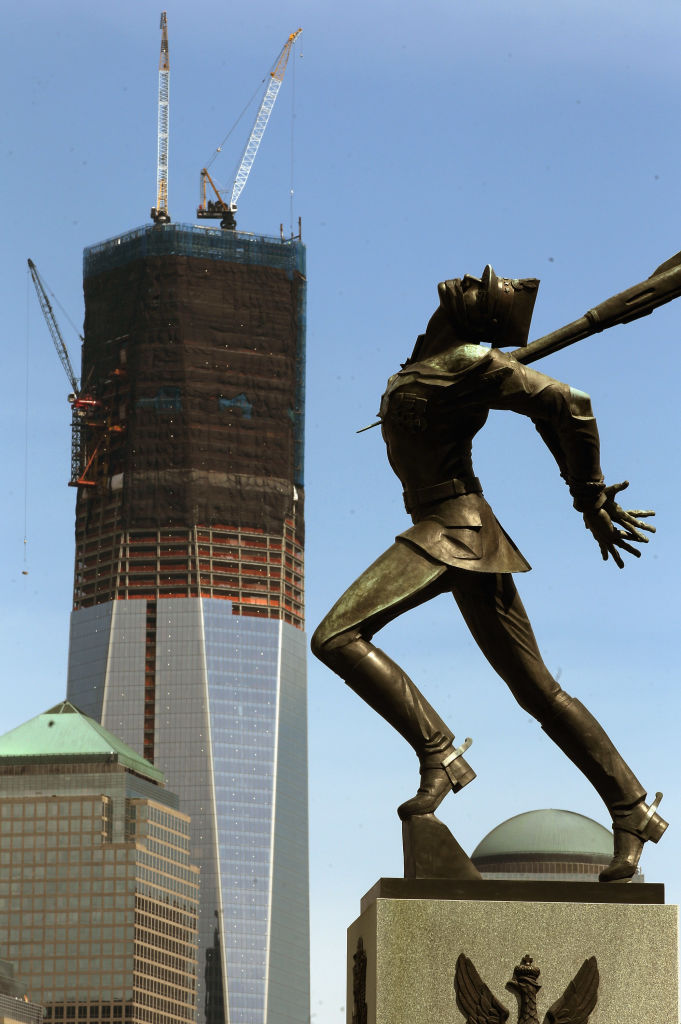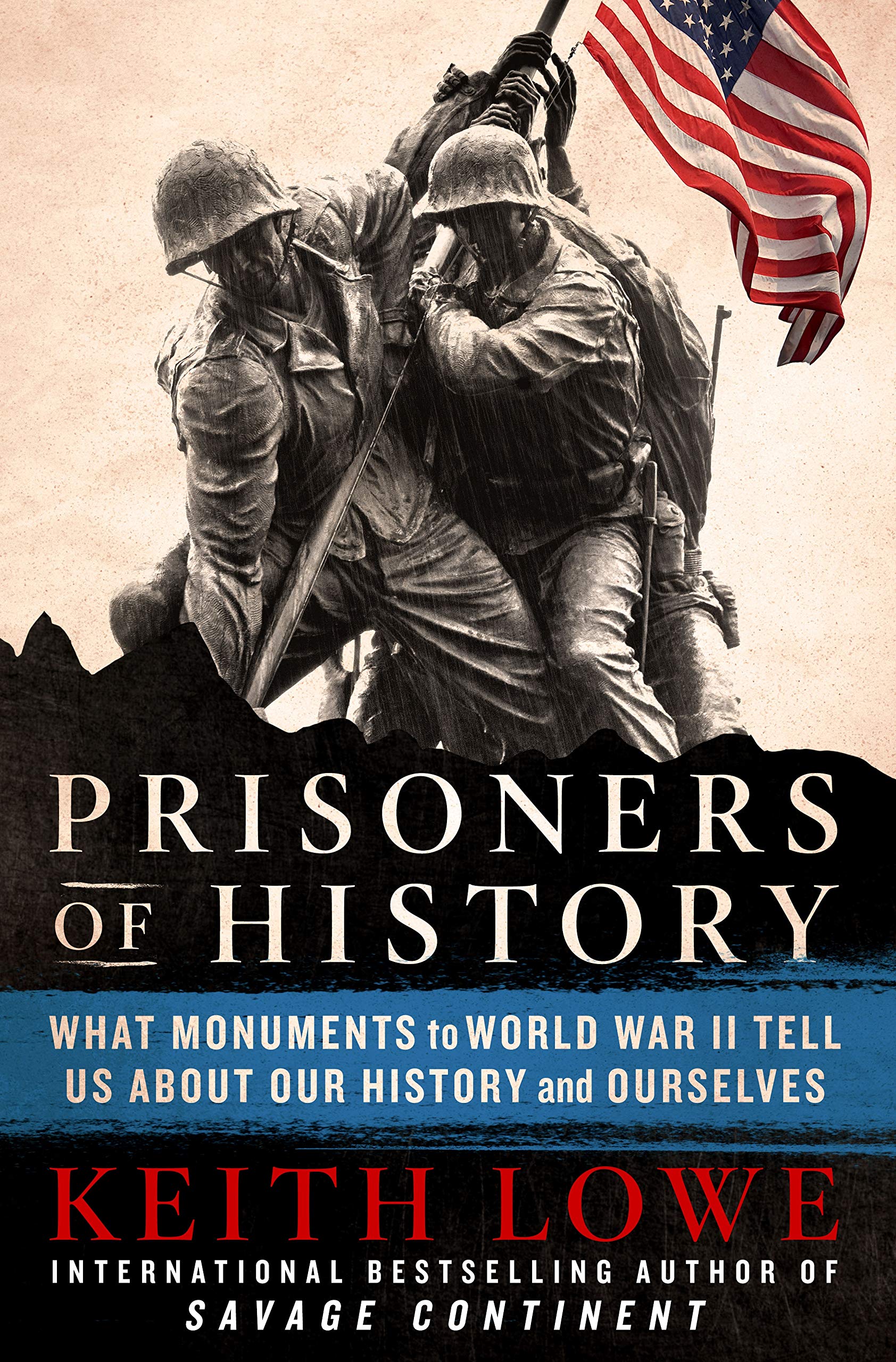
In Jersey City, overlooking the Hudson River, stands one of the most dramatic Second World War memorials in the world. Thirty-two feet high, standing on a granite plinth, is a bronze statue of a bound-and-gagged soldier being stabbed through the back with a bayonet. He appears to be in the throes of death. His body is arched in pain, and his face is tilted up towards heaven. The point of the bayonet emerges through the left side of his chest, exactly where his heart is.
The memorial commemorates an atrocity committed in 1940 by the Soviet secret police: the massacre of thousands of Polish officers in the Russian forest of Katyn. Ever since it was first installed in 1991, the monument has divided local opinion. Some residents complain that it is ugly and vulgar, and that its depiction of violent death is simply too graphic. But others have always defended it as darkly beautiful. The feelings of discomfort it provokes, they say, are exactly the emotions that a good war memorial should inspire.
In May 2018, however, the statue suddenly became the center of a quarrel that went far beyond local sensibilities. It began when the mayor of Jersey City, Steven Fulop, announced plans to move the monument to a different place nearby. The area was being redeveloped, and the spot was earmarked as the location of a new, riverside public park. The statue had to be moved to make way for this new development.
A group of Polish Americans immediately protested against the move and launched a lawsuit against the city council: it was their memorial, and they did not feel properly consulted. They were backed up by other local residents, who opposed the redevelopment plan more generally.
Within days, the issue had escalated into a full-blown international incident. The Polish ambassador to the U.S. complained on social media about the monument’s relocation. Politicians in Poland accused Jersey City of disrespecting Polish heroes, and condemned their plans as “really scandalous.” Mayor Fulop hit back by accusing one of these politicians of being a “known anti-Semite” and “holocaust denier,” prompting the politician in question to take legal action. The developer tasked with renovating the area denounced the monument as “gruesome”; the artist who designed it called the developer a “schmuck.”
For neutral observers, this unseemly spectacle raises all kinds of questions. Why were local people so quick to take offense, when all that seemed to be happening was that the memorial was being moved from one prominent place to another, just a few hundred meters away? Why all the fuss now, more than 70 years after the Second World War was over? And most importantly, what was this statue doing in New Jersey in the first place?
So many different themes demand attention here, both local and international, that it is difficult to know where to start. But the element that binds them together into such an insoluble tangle is history. There could be no better demonstration of how impossible it is to escape our history, especially when that history involves an element of victimhood.
It is worth taking a moment to consider what exactly the memorial commemorates, because, like many memorials, this one is not quite as straightforward as it seems. At the very beginning of the Second World War, while Poland was defending itself from the German invasion, it was attacked again, this time by the Soviets, from the rear. In other words, it was “stabbed in the back.”
Get your history fix in one place: sign up for the weekly TIME History newsletter
Within a few weeks, the country was split down the middle: the Nazis ruled in the west, the Soviets in the east. The Soviet occupiers were just as cruel as the Nazis. The most notorious killing grounds were in the Russian forest of Katyn, where several thousand Polish army officers were murdered and piled into mass graves. These terrible events are quite literally at the heart of the monument: buried within its granite base is soil taken from the forest where the atrocities were committed.
But, while the monument is ostensibly dedicated to the Katyn massacres, the word “Katyn” has itself become a symbol of every betrayal that the Poles were forced to suffer during the second half of the twentieth century. The soldier who is being bayoneted upon his plinth represents much more than the thousands of Polish officers killed at Katyn in 1940. He represents Poland itself, in all its tragic martyrdom.
It is tempting to leave the analysis here: the monument is a national symbol, representing national suffering. But to the people who built it, it is much more than that. It is intimately bound up not only with Polish history, but also with the local history of Jersey City, and the personal history of those who came here in the aftermath of the war. In 1945, there were more political refugees from Poland than from any other European country. Of the 200,000 or so who ended up in the U.S., around 10,000 settled in New Jersey; there, several decades later, a group of Polish veterans gathered to discuss ways of commemorating the various tragedies they had lived through. The result was the memorial, inaugurated in June 1991.
In the following years, however, gentrification began to sweep the city, driving up prices and driving out many of the older, blue-collar residents. The redevelopment of Exchange Place, where the Katyn Memorial is situated, was just the latest instance. An important element of the protest against moving the memorial was nothing to do with Polish identity or memories of the Second World War, but about local identity and memories of a community that was fast disappearing.
International history, national history, local history, personal history—each of these layers is represented in this one memorial. And each layer is suffused with trauma and deep feelings of suffering and betrayal. The Katyn monument is one of the most emotionally charged memorials in the world. Is it any wonder, then, that Steven Fulop’s surprise announcement that the monument would be moved away from Exchange Place—purely for the sake of commercial redevelopment—was greeted with such defensive outrage?
In the days after the announcement was made, debates about it took place in the local and national newspapers, on social media, in the city council, on Polish radio, and between Polish and American diplomats. At the center of this storm of emotion stood the local Polish-American community, many of whom felt betrayed all over again.
Across the Atlantic, in Poland, there was a much better understanding of the emotions involved, but even here they did not quite get the full picture. Poland embraced the Katyn Memorial as a symbol of Polish identity, when in fact it was something slightly different—it was a symbol of Polish-American identity. It commemorates a specific kind of loss, and a specific kind of martyrdom, unique to those Poles who were forced into exile after 1945.
The local dimension to the controversy could only be fully appreciated by Jersey City residents. The city’s old-timers already felt betrayed by their council, who appeared to be putting the needs of newcomers and big businesses above their own. To such people, the Katyn Memorial was the symbol of a local identity that was itself being stabbed in the back. One city councilor, Rich Boggiano, was particularly vocal about leaving the memorial where it was. “I’m sick and tired of all these new people coming here,” he told the local newspaper, “wanting to change everything about Jersey City.
Once people get riled up, it is difficult to calm them down again. The city council tried to rectify their mistake and started to consult local Polish-American community leaders, but it was too late. They promised to move the monument just one block south, but indignant protesters refused to negotiate. Anyone who argued in favor of the move was shouted down. The Polish president himself gave the relocation his blessing, but was immediately denounced by local protesters as a traitor to their cause: in May 2018, when he made a personal visit to the memorial, he was greeted there by demonstrators with cries of “Shame!”
The forces that fueled this maelstrom of protest were memory and martyrdom—which in the minds of the protesters combined to form a single entity called “history.” At council planning meetings they accused the city of trying to “erase history.” At their public demonstrations they unfurled huge banners which read “Respect Our History.” This history was more important to them than progress, or harmony, or compromise, or anything else; and any threat to it was regarded as a threat to their very identity.
Eventually, after several heated meetings, two petitions and the scheduling of a public referendum, the city council backed down. The subject of the monument had simply become too toxic, and threatened to disrupt too much other business.
There are different ways of viewing this story, depending on your political point of view. You might see it as a victory for the common citizen, standing up fearlessly against the combined forces of power and money. Or you might see it as a defeat for the forces of progress, held to ransom by a hysterical mob. Either way, it demonstrates one fundamental truth: in the day-to-day running of our communities, we are all prisoners of our history.

Excerpted from PRISONERS OF HISTORY: What Monuments to World War II Tell Us About Our History and Ourselves by Keith Lowe. Copyright ©2020 by the author and reprinted by permission of St. Martin’s Publishing Group.
More Must-Reads from TIME
- Cybersecurity Experts Are Sounding the Alarm on DOGE
- Meet the 2025 Women of the Year
- The Harsh Truth About Disability Inclusion
- Why Do More Young Adults Have Cancer?
- Colman Domingo Leads With Radical Love
- How to Get Better at Doing Things Alone
- Michelle Zauner Stares Down the Darkness
Contact us at letters@time.com